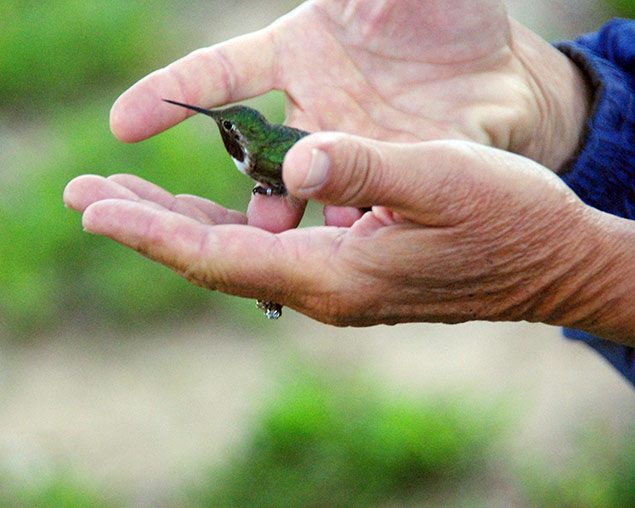Hummingbirds are beautiful and charismatic, but not as well studied as many other birds. Some hummingbird species in the U.S. might be in decline, so monitoring them to estimate their abundance and detect trends in their populations is an important step towards developing a conservation strategy.
Why study hummingbirds?

Photo by Natalie Melashenko
Hummingbirds are the second most diverse family of birds, with about 340 species that are found only in the western hemisphere. While the majority of hummingbird species are found in South America, 57 species are found in North America. Of these, 40% are endemic, 30% migrate long distances between Canada, the U.S., and Mexico, and 14% are of high conservation concern. Seventeen species occur in the U.S. and Canada, and 13 of these are neotropical migrants that overwinter in Mexico. Of these, four have been identified by the U.S. Fish and Wildlife Service and Partners in Flight, a nonprofit agency dedicated to conserving bird populations in the western hemisphere, as species that are in need of conservation actions: Costa’s (Calypte costae), Calliope (Stellula calliope), Rufous (Selasphorus rufus) and Lucifer (Calothorax lucifer).
Hummingbirds, with their beautiful plumage and aerial acrobatics, are very charismatic fauna. Despite their popularity, they are not as well studied as many other bird families. In fact, it is those characteristics that make hummingbirds so fascinating that also make them difficult to study. Their small size, rapid movements, high-pitched vocalizations, unique flight abilities and other factors make it difficult to monitor hummingbirds with techniques used to monitor other landbirds.
Recent indications that some hummingbird species in the U.S. might be in decline have drawn attention to the need for a conservation strategy. However, without adequate information about hummingbird biology and habitat requirements, it would be difficult, if not impossible, to design a conservation program for these birds. The Hummingbird Monitoring Network (HMN) is a nonprofit organization that was founded in 2002 to meet this need.
The Hummingbird Monitoring Network

Photo by Jean Palumbo
HMN takes a science-based, project-focused approach to the conservation of hummingbird abundance and diversity throughout the western hemisphere. The organization’s four-part strategy involves: 1) long-term monitoring of hummingbird populations, 2) support of research that advances hummingbird conservation, 3) support for the preservation of hummingbird habitats, and 4) education of stakeholders about hummingbird conservation, including land-management agencies, landowners, the scientific community, and the public.
Monitoring hummingbirds in order to estimate their abundance and detect trends in their populations is the first step in developing a conservation plan. One of HMN’s goals for monitoring is to identify long-term monitoring sites which best represent the diversity of hummingbirds in North America. To this end, the network began establishing monitoring sites in southeast Arizona and California, and later in British Columbia, Canada. Monitoring at these sites resulted in the detection of juveniles migrating from British Columbia, down through California and southeast Arizona.
Monitoring Hummingbirds in the National Parks

Photo by Jean Palumbo
In 2005, the number of migrants coming through California and Arizona dropped off. One hypothesis for this decline was that the birds had shifted their migration to go through the Rocky Mountain route of the Central Flyway, where the wildflowers had been particularly abundant that year. In order to test this hypothesis, HMN needed to establish monitoring sites along the flyway. In 2007 the Hummingbird Monitoring Network began monitoring hummingbirds at Mesa Verde National Park, near the southern portion of the Rocky Mountains. Later, in 2010, hummingbird monitoring was begun at Bryce Canyon National Park, the Grand Staircase–Escalante National Monument Visitor Center at Escalante, and at Calf Creek Campground on the monument. With the expansion of monitoring into Utah and Colorado, the Hummingbird Monitoring Network is able to collect information about hummingbird populations in areas that may prove to be major migration routes.
The Monitoring Program

Photo by Natalie Melashenko
The Hummingbird Monitoring Network’s monitoring program is a systematic banding study that also utilizes counting techniques and is designed to generate knowledge about hummingbird diversity, abundance, productivity, and survivorship at monitoring sites. Bird banding is a universal technique for studying birds that is overseen by the North American Bird Banding Program (NABBP), which is jointly administered by the U.S. Department of the Interior and the Canadian Wildlife Service. Potential bird banders must undergo a rigorous training program and be issued a permit by the NABBP.
In a bird banding study, wild birds are captured and marked with a uniquely numbered band that is affixed to their leg. Associated with that number is information about where and when the bird was captured, age, sex, and any other information that the bander elects to record. This information is sent to the NABBP. When a banded bird is trapped again in another location, that information, when sent to the NABBP, provides data about such things as the distribution and movement of species, their relative numbers, life span, and cause of death.
At Mesa Verde National Park, the monitoring program is administered by a group of volunteers and assisted by park staff. At Bryce Canyon National Park, the park biologist administers the program, assisted by volunteers. Bureau of Land Management and Dixie National Forest biologists manage the Escalante and Calf Creek sites. For information about the Hummingbird Monitoring Network, please visit: http://www. hummonnet.org/.
References
Birdlife International. 2008. The list of vulnerable to endangered hummingbird species. Available at: http://www. birdlife.org/datazone/species/index.html.
Gustafson, M. E. and J. Hildenbrand, 1999. Bird Banding Laboratory Homepage, ver 07-10-2005. http://www. pwrc.usgs.gov/BBL/homepage/introduction.htm (accessed 6.10.2010).
Wethington et al. 2010. The Western Hummingbird Partnership Action Plan: Working together to maintain thriving hummingbird populations and their habitats. Available at: http://www.hummonnet.org/pdf/201006whp_actionplan. pdf.
Wethington, S. 2006. Study plan for hummingbird monitoring in national parks. Proposal to Mesa Verde National Park. The Hummingbird Monitoring Network, Patagonia, Arizona.
Last updated: February 3, 2015
